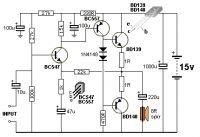Enzy
Advanced Member level 1
I have been here several times trying to create a good audio amplifiers and amplifiers so far I havent had any help creating an amplifier so I tend to resort to Chinese made amplifier boards that I buy on ebay I am not sure if its my preamp that seems to be giving me some sounds that arent so clean, there is not much of a hum in the sounding but once music is playing at a certain level its not very clean and its not clipping. I would lean to beleive thast its the amplifiers that aren't playing all that clean.
I would like to know all the major sections of an amplifer not in a fine comb detailed way but laying it out like a lock diagram it doesnt have to be all that needed for example speaker protection circuits which I have never used before.
so for my builds I would generally have:
power supply stage
fan circuit
preamp stage
amplifier
and thats it.
I havent even been able to find a simple VU meter or peak detection circuit which doesnt use many lights possible 4 or less LED's.
Another thing is I would love to build a high quality preamp board which I can use on all amplifiers from bass to tweeters 2 channels and stereo, so that would generally be 20hz to 20khz.
I have always asked for help to create an amplifier class D seems be a challenge so I would work with a class AB amplifier also something using FETS which can be easily upgraded interms of power rating since I would generally go for high powered amplifiers and 2ohms would be the target for connected speakers 2 channel also.
I have been busy coding with arduino and teaching myself and doing some projects that I couldn't do much audio projects but I have already bought resistors and caps of various sizes and Fets and single and dual opamps.
It would be nice to get some help and I would like to document everything as I go also.
I would like to know all the major sections of an amplifer not in a fine comb detailed way but laying it out like a lock diagram it doesnt have to be all that needed for example speaker protection circuits which I have never used before.
so for my builds I would generally have:
power supply stage
fan circuit
preamp stage
amplifier
and thats it.
I havent even been able to find a simple VU meter or peak detection circuit which doesnt use many lights possible 4 or less LED's.
Another thing is I would love to build a high quality preamp board which I can use on all amplifiers from bass to tweeters 2 channels and stereo, so that would generally be 20hz to 20khz.
I have always asked for help to create an amplifier class D seems be a challenge so I would work with a class AB amplifier also something using FETS which can be easily upgraded interms of power rating since I would generally go for high powered amplifiers and 2ohms would be the target for connected speakers 2 channel also.
I have been busy coding with arduino and teaching myself and doing some projects that I couldn't do much audio projects but I have already bought resistors and caps of various sizes and Fets and single and dual opamps.
It would be nice to get some help and I would like to document everything as I go also.


